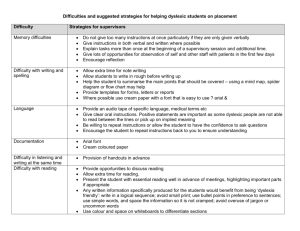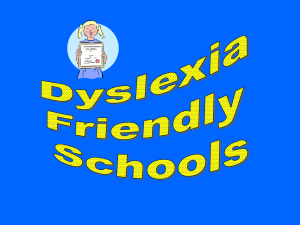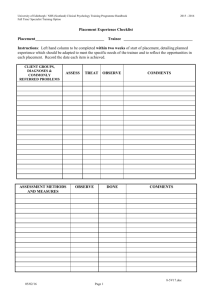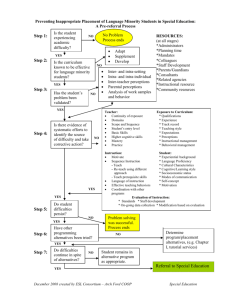support document
advertisement
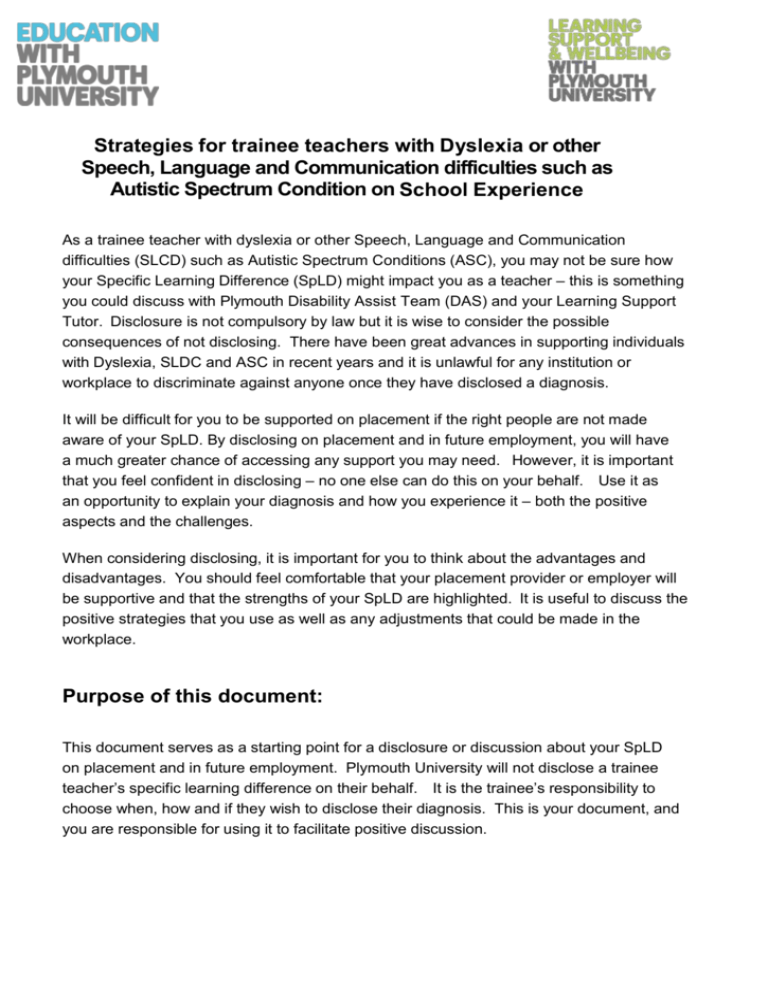
Strategies for trainee teachers with Dyslexia or other Speech, Language and Communication difficulties such as Autistic Spectrum Condition on School Experience As a trainee teacher with dyslexia or other Speech, Language and Communication difficulties (SLCD) such as Autistic Spectrum Conditions (ASC), you may not be sure how your Specific Learning Difference (SpLD) might impact you as a teacher – this is something you could discuss with Plymouth Disability Assist Team (DAS) and your Learning Support Tutor. Disclosure is not compulsory by law but it is wise to consider the possible consequences of not disclosing. There have been great advances in supporting individuals with Dyslexia, SLDC and ASC in recent years and it is unlawful for any institution or workplace to discriminate against anyone once they have disclosed a diagnosis. It will be difficult for you to be supported on placement if the right people are not made aware of your SpLD. By disclosing on placement and in future employment, you will have a much greater chance of accessing any support you may need. However, it is important that you feel confident in disclosing – no one else can do this on your behalf. Use it as an opportunity to explain your diagnosis and how you experience it – both the positive aspects and the challenges. When considering disclosing, it is important for you to think about the advantages and disadvantages. You should feel comfortable that your placement provider or employer will be supportive and that the strengths of your SpLD are highlighted. It is useful to discuss the positive strategies that you use as well as any adjustments that could be made in the workplace. Purpose of this document: This document serves as a starting point for a disclosure or discussion about your SpLD on placement and in future employment. Plymouth University will not disclose a trainee teacher’s specific learning difference on their behalf. It is the trainee’s responsibility to choose when, how and if they wish to disclose their diagnosis. This is your document, and you are responsible for using it to facilitate positive discussion. It is important that you understand the adjustments you can make to your practice, based on a good understanding of your own profile of strengths and difficulties. Discussions should be positive and show that you are able to take responsibility for your own working practice. Following are examples of possible strategies a trainee teacher with dyslexia and ASC may find useful and may choose to integrate into their teaching. This list is not comprehensive, and trainee teachers are encouraged to discuss their individual approaches to teaching with their placement provider directly. Please contact Disability Assist or the Careers & Employability Service if you would like further information or support with positive disclosure in the workplace: Disability Assist The Learning Gateway 011, Roland Levinsky Building Reception: 01752 587676 E: das@plymouth.ac.uk Successful trainee teachers with dyslexia, SLCD or ASC will: Understand their diagnosis to be a specific learning difference (SpLD) Have a good understanding of their strengths and develop approaches to teaching to make best use of these Be aware of the factors that challenge them on placement and develop individual strategies to minimise these Be able to effectively communicate their strengths and challenges as part of positive disclosure on placement and in future employment Spend time considering possible individual teaching and learning strategies well before placement starts. Take responsibility for adapting their teaching approach to best suit their individual profile of strengths and difficulties Be aware of any reasonable adjustments that could be made for support on placement and be able to discuss these with a placement provider or employer as relevant Be efficient in following up paperwork in regard to Disabled Students’ Allowances (DSA) funding so that there is as little delay as possible in receiving support and / or equipment. Take advantage of support offered within the university (e.g. Disability Assist and the wider Learning Support and Wellbeing department, e.g. the Writing Café run by Learning Development), and externally (e.g. Assistive Technology training providers), and proactively engage with these services as required. Communicate any difficulties experienced on placement with the School Experience team and / or Disability Assist as soon as possible so that advice and additional support can be offered. Understand that although reasonable adjustments may be implemented, teaching standards must still be met in line with the placement requirements and programme outcomes. Understand the difference between university and the placement setting Understand that their needs may be different in different schools and different environments Remain engaged with Plymouth Institute of Education and Disability Assist for the duration of their degree and deal with any challenges that may arise quickly and openly Below are some of the strengths and difficulties you may experience as a trainee teacher with a specific learning difference. Please tick any that you feel are relevant to you. It is important that you really understand how you work best as both a student and a teacher – make sure that you refer back to your diagnostic report to be sure that you really understand your profile of strengths and areas of challenge. Remember: No two trainee teachers with SpLDs are the same – your profile is individual to you. The strategies that you implement to minimise your difficulties are based on your own preferences – only you know what works for you. This list is not exhaustive – you may use strategies that are not indicated. Please add your own in the space provided. The Disabled Students Allowance is available to support you to better understand your profile as a trainee teacher with an SpLD Strengths you may have as a trainee teacher with an SpLD: Strengths ☐ Visual and Spatial Awareness Benefits to teaching Making use of images, diagrams, and visualisation to support teaching; being able to teach holistically rather than just focusing on the parts. ☐ Auditory Awareness Teaching and explaining through discussion; listening to points raised by children in class. ☐ Creative Skills Teaching by finding similarities and differences in information and comparing; supporting children to connect dots to compare new information with old; creatively finding solutions Being able to look at the whole picture and find the best solution by comparing the options; outweighing possibilities through trial and error. ☐ Problem Solving ☐ Multi-sensory Techniques Involving two or more senses in the teaching and learning process (e.g. speaking out loud combined with writing things down); Awareness of multisensory teaching techniques ☐ Sensitivity Understanding where others are coming from; empathetic attunement to others; particular empathy with dyslexic pupils ☐ Reasoning Looking at the bigger picture and coming to a solution by analysing possibilities ☐Ingenuity Originality and creativity; well-rounded sense of learning and teaching Other strengths you’ve identified ☐ Benefits to you as a teacher * * * * ☐ * * * ☐ * * Difficulties often associated with SpLDs and possible strategies for managing them: General difficulties ☐ Information Processing: Difficulties taking information efficiently; slowed speed of information processing (delay between hearing something + understanding something + responding to it) ☐ Short-term Memory: Poor short-term memory for facts, events, times, and dates. If interrupted, information will not be remembered. ☐ Sequencing: Difficulty presenting a sequence of events in a logical, structured way; difficulties with organisation and time management; incorrect sequencing of numbers or letters Strategies I can use as a teacher Ask questions for clarification Write down instructions and check to be sure you have understood. Keep a notebook with you. Have a contact book between you and the teacher in a central place. Find time & space to do work quietly without distraction. Take notes during meetings Use a digital recorder Request written notes as follow-up to meetings Use a digital recorder Organise information into themes Repeat information out loud Highlight notes using different colours Close book or notes and recall information or summarise Break instructions down into steps Write very detailed lesson plans with clear timings and stick to them. Practice lesson introductions beforehand. Ask for instructions to be given in writing, by email Use visual prompts in the classroom – days of the week; numbers; alphabet; class timetables with clear timings Have bullet points for introductions, key words and topic related spellings displayed by board for children and you Use the file document examples on the portal for reference General difficulties Strategies I can use as a teacher ☐ Time Management: Difficulties estimating time taken to complete tasks; multitasking; meeting deadlines ☐ Visual Processing: Reduced ability to make sense of information taken through eyes; difficulties affect how visual information is interpreted or processed ☐ Visual stress Text can appear distorted and words/letters appear to move or become blurred Create a weekly planner for the wall. Put a year planner on the notice-board. Mark deadlines and meetings in a bright colour Use a diary with a large page for each day and lots of blank pages for notes. Use a kitchen timer, so that you can time lessons effectively Use your mobile phone if you have one. You may be able to set an alarm, or add reminder notes for yourself Post-it notes can be useful, for example to place on your desk to remind you what you need to do each day Negotiate a space in the classroom large enough to keep your resources organised ready for the day. In negotiation with the mentor, focussed observations and weekly reviews may be voice recorded. Manage personal organisation by using equipment Such as: A set of stacking trays for papers. A concertina filing system. Colour-coded ring binders for each section of your course. ☐ Working memory: Difficulty holding onto several pieces of information while undertaking a task (e.g.: taking notes as listening); difficulty with mental maths; difficulties remembering instructions, facts, numbers; problems with amount of information that can be held and processed; difficulties copying from the board, Block out extraneous visual stimuli. Use a blank sheet of paper to cover sections of the page not being worked on at the time. Use a reading ruler to focus attention on section being read Print your own paperwork on coloured paper Follow up getting tinted lenses and wear your glasses in class Get a coloured overlay or A4 pocket for reading documents Take a photograph of the board when finished writing on it Use post-it notes Use your digital recorder or the recording function on your ‘phone Ask teacher to write in contact book if there are instructions whilst you are teaching. When given instructions ‘on the go’ ensure you write them in a notebook. Other difficulties you’ve identified Strategies that work for me as a teacher ☐ ☐ ☐ ☐ ☐ ☐ ☐ ☐ ☐ ☐ ☐ ☐ Strategies for managing possible difficulties in the classroom: Possible difficulty Suggested strategies Spelling Put key words onto lesson plans and refer to them Get the pupils to help you to spell Get a non-dyslexic colleague to check spelling Get students to correct spelling (reward stickers) Use mobile device or electronic spellchecker to check spelling Keep dictionaries to hand Have a word wall on display with commonly misspelt words Write all difficult words in corner of the board Use the Ace Spelling Dictionary Have your commonly misspelt words and vocabulary for marking in your notebook to refer to quickly Writing on a whiteboard Use PowerPoint presentations to minimise writing on board Get pupils to be scribes to write on board Display key vocabulary by the board for quick reference. Report writing Make sure you are able to write reports electronically Make use of templates wherever possible Seek assistance initially until you are more confident Make use of 1:1 support at the university to develop writing skills Develop own or use an online comments bank Start writing reports early Ask a colleague to proof read Spend longer proof reading reports Use text to speech software to help with proofreading eg to hear any errors such as an incomplete sentence or a mistyped word Use text to speech software such as Claroread & Texthelp (these have inbuilt homophone checkers to detect possible mistakes with words like their/there/they’re) Use voice recognition software such as Dragon Naturally Speaking Possible difficulty Suggested strategies Remembering names of pupils / staff / parents When taking register, put a photo or a phonetic spelling by the name Have a seating plan file so that names can be learnt Play name games Ask pupils to create name stickers Use a seating plan Write distinguishing features next to the names on the register Organisation and time management Use your lap top where possible; keep everything electronically Write to-do lists Use a diary – paper or electronic Use post-it notes Read reports and paper before meetings Have one place for everything Write everything in one book Use different coloured files Ensure 25% time is in large blocks. Lesson planning Use lesson plan templates available in schools Use mind mapping software such as Inspiration, particularly useful for visual learners. Create visual mind maps containing key information and pictures, and showing connections. Identify one key idea to keep focused Make lessons practical where applicable Checking written work Get children to peer assess their work Reading Prepare in advance Break up text into chunks Use coloured pens, fonts and paper Take pauses when reading out loud Highlight important sentences Make use of a Quicktionary Reading Pen with OCR software to help with the occasional word (also has a dictionary for meaning) Make use of text to speech software for reading longer documents and to support proofreading of emails etc. e.g. ClaroRead, TextHelp Observations Use a scanner to scan pages of a textbook to use with screen reading software Make use of a digital recorder to note observations verbally at the time to ensure you don’t forget. Other possible difficulties Adjustments I will make to my teaching ☐ ☐ ☐ Are there any other reasonable adjustments you would like to discuss with the school? To summarise, my personal disclosure statement is: As a trainee teacher with a specific learning difference, I have strengths in the following areas: These strengths are a benefit to my teaching, in that they allow me to: I experience some difficulties, including: And I use the following strategies to manage these difficulties: In the classroom I find it really useful to teach by: Adapted from Roehampton University’s document for trainee teachers on placement, ‘Strategies for dyslexic trainee teachers on Block School Experience’ The following resources may also be useful to you: University of Southampton – Supporting dyslexic PGCE trainees and teachers: http://www.southampton.ac.uk/assets/imported/transforms/peripheralblock/UsefulDownloads_Download/718F25F4FB4346CE876C54422C233E67/suppo rting_dyslexic_trainees_and_teachers.pdf Teacher strategies: http://www.visd.com/depart/specialprograms/dyslexia/dyslexia_handbook_teacherstr ategies.pdf BrainHE – resource website for students in Higher Education, outlining useful learning strategies. http://www.brainhe.com/
